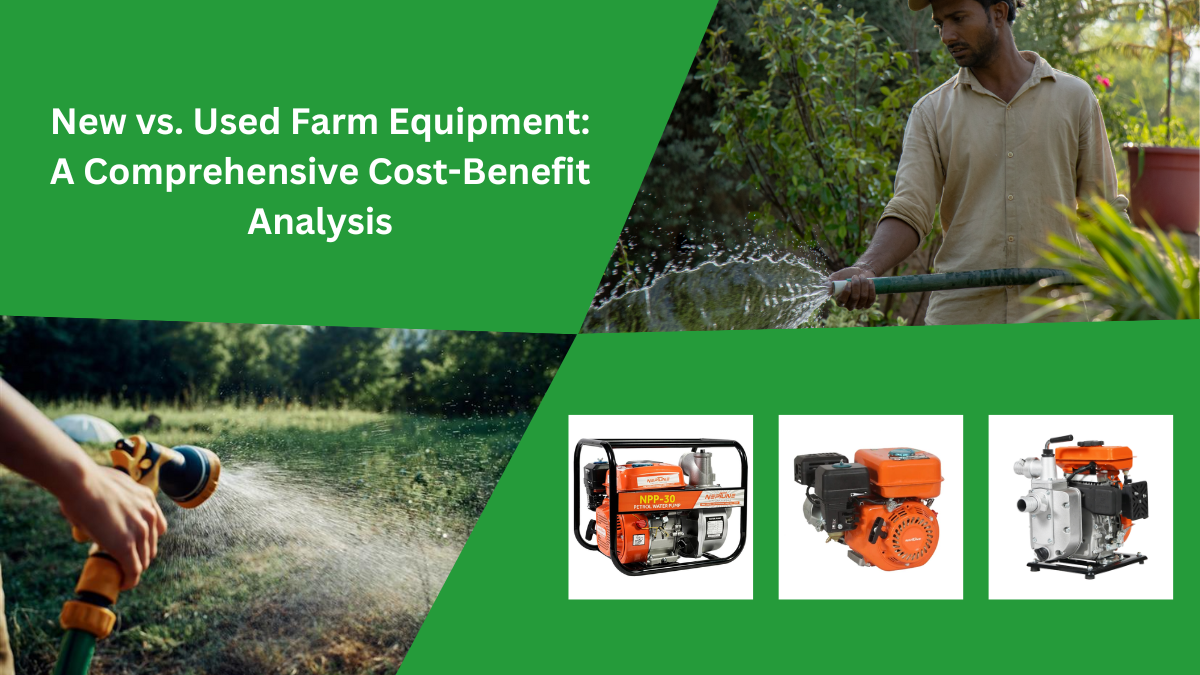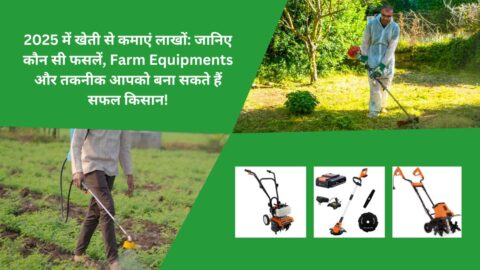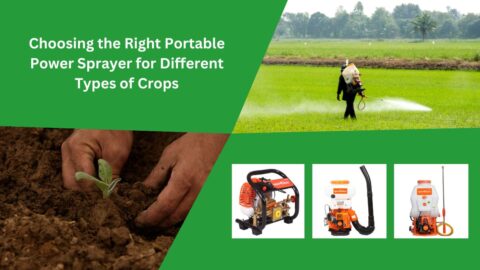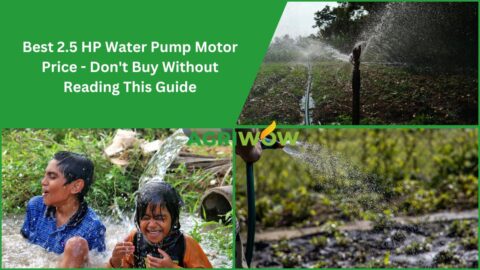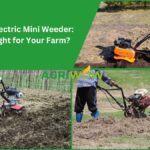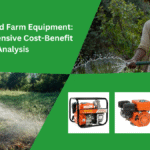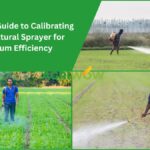Every farmer faces this question at some point should I buy new farm equipment or go for used machinery? It’s a big decision that impacts your budget, productivity, and even long-term sustainability. Both new and used equipment have their strengths and downsides. While new machines bring the latest technology and reliability, used ones are easier on the wallet and often just as functional.
In this blog, we’ll break down the cost-benefit analysis of each option, explore their pros and cons, and understand how these choices fit into diversified and sustainable farming models like Neptune Farming, which includes aquaculture and other eco-friendly practices.
Pros and Cons of Buying New Farm Machinery vs Used
1. Advantages of Buying New Farm Equipment
a. Advanced Technology and Efficiency
New equipment comes with cutting-edge features GPS guidance, automation, smart sensors, and digital controls that make farm work more precise and efficient. These technologies help save fuel, reduce human error, and optimize input use, ultimately improving yields and cutting costs in the long run.
b. Reliability and Warranty
With new equipment, you get peace of mind. Manufacturers usually offer warranties that cover parts and services for the first few years. This means fewer worries about unexpected breakdowns and repair bills, helping farmers stay focused on their work.
c. Better Fuel Efficiency and Lower Emissions
Modern machines are built to meet environmental standards, offering improved fuel efficiency and reduced emissions. This helps farmers save money on fuel while contributing to a greener planet.
d. Easier Financing and Insurance
Financial institutions prefer lending for new machinery. They often offer attractive loans and insurance packages, making it easier for farmers to invest in new tools without straining their finances.
2. Disadvantages of Buying New Equipment
a. Expensive Upfront Cost
The biggest downside of buying new is the price tag. Tractors, harvesters, or implements can be very expensive, especially for small and medium farmers. Comparing farm equipment prices from different brands is essential before making a purchase to ensure the best deal.
b. Rapid Depreciation
Like new cars, new farm machines lose value quickly. Within just a few years, the resale value can drop significantly, affecting the overall return on investment.
c. Complex Maintenance Requirements
With advanced technology comes more complexity. Modern machines often require specialized technicians or service centers for repairs, which can be costly and time-consuming.
3. Advantages of Buying Used Farm Equipment
a. Lower Purchase Cost
Buying used farm machinery is much more affordable. It allows farmers to start or expand operations without taking on heavy debt. The savings can be redirected toward seeds, fertilizers, or irrigation systems — essential for farm growth.
b. Slower Depreciation
Used equipment has already passed through the steep depreciation phase, meaning its value won’t drop as quickly. This makes it a safer investment if you plan to sell or trade it later.
c. Wide Availability and Flexibility
There’s a large market for used machines, offering plenty of choices in agriculture farm equipments across various brands and sizes. Farmers can find equipment that fits their exact needs without long waiting periods or high costs.
4. Disadvantages of Buying Used Equipment
a. More Maintenance and Repairs
Older machines may require frequent servicing. Parts might be worn out, and replacement can be difficult if the model is outdated.
b. No Warranty or Guarantee
Most used equipment doesn’t come with a warranty, meaning farmers have to handle any future breakdowns or repairs on their own.
c. Outdated Features
Used machinery may not include new technology like fuel-efficient engines or precision farming tools, which can limit productivity and increase fuel costs.
Cost-Benefit Analysis of Diversified Farming Systems in Aquaculture: Incorporating Non-Market Ecosystem Services for Neptune Farming
Modern farmers are increasingly adopting diversified farming systems, where aquaculture the cultivation of fish and aquatic plants is combined with traditional crop farming. Under the Neptune Farming approach, sustainability, cost-effectiveness, and resource optimization go hand in hand.
Let’s explore how the choice between new and used machinery affects cost, sustainability, and productivity in such integrated systems.
1. Cost Efficiency
Aquaculture setups often require tools like aerators, pumps, and sprayers. Buying used equipment can help reduce initial costs, especially for farmers starting out. However, new machines such as the neptune water pump are often more energy-efficient and reliable, leading to lower operating costs over time.
2. Sustainability and Environmental Impact
Sustainable systems prioritize reduced emissions and water conservation. New farm equipment aligns with these goals since it’s designed with eco-friendly engines and better efficiency. However, reusing or refurbishing used equipment also supports sustainability by minimizing waste and reducing manufacturing emissions — a key principle in circular farming models like Neptune Farming.
3. Productivity and Reliability
In aquaculture, consistency is crucial. A malfunctioning pump or sprayer can quickly disrupt water circulation and harm aquatic life. That’s why many farmers prefer new equipment for reliability and long-term stability, even if it costs more upfront. Still, properly maintained used machines can deliver strong performance when chosen carefully.
4. Valuing Non-Market Ecosystem Services
Neptune Farming also highlights the value of ecosystem benefits like soil health, clean water, and biodiversity — things that don’t always have a price tag but are essential for long-term sustainability. Using efficient machines such as sprayer agriculture machines, brush cutter machines, or modern water pumps helps preserve these natural resources by minimizing pollution and resource wastage.
Final Thoughts
So, what’s the right choice new or used?
If your priority is efficiency, performance, and long-term sustainability, investing in new farm equipment makes sense. It ensures reliability, better productivity, and reduced environmental impact.
However, if you’re managing a tight budget or starting small, used machinery can be a smart and practical choice. It allows you to scale operations without a huge upfront investment.
At the end of the day, both paths can lead to success — it all depends on your farming goals, resources, and how you maintain your tools. Whether it’s traditional farming or a sustainable model supported by neptune industries, the best decision is one that balances cost, efficiency, and care for the environment.
FAQ
1. Is it better to buy new or used farm equipment?
It depends on your budget, farm size, and long-term goals. New equipment offers the latest technology, better fuel efficiency, and warranty protection — ideal for farmers looking for reliability. On the other hand, used farm machinery is much cheaper upfront and depreciates slower, making it a smart choice for small or medium-sized farms.
2. How can I compare farm equipment prices before buying?
To compare farm equipment prices, start by checking both online marketplaces and authorized dealers. Evaluate features, model year, condition, and warranty options. Also, factor in operational costs such as fuel, spare parts, and maintenance before making a final decision. This helps ensure you get the best value for your investment.
3. What should I check before buying used agriculture farm equipment?
Before buying used agriculture farm equipments, inspect the machine thoroughly for wear and tear, engine condition, and maintenance records. Ask for a test run to check performance, and verify if spare parts are easily available. Buying from trusted sources like certified resellers or verified listings ensures better reliability and long-term savings.

